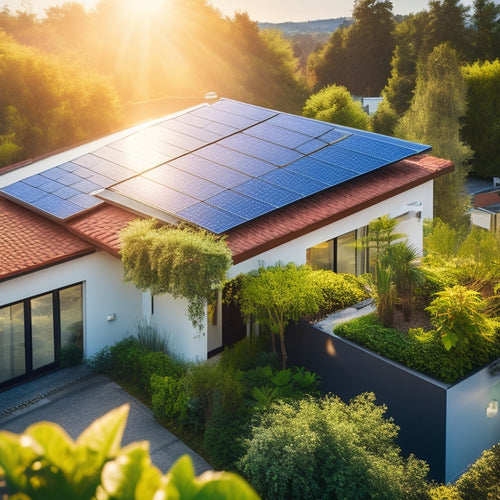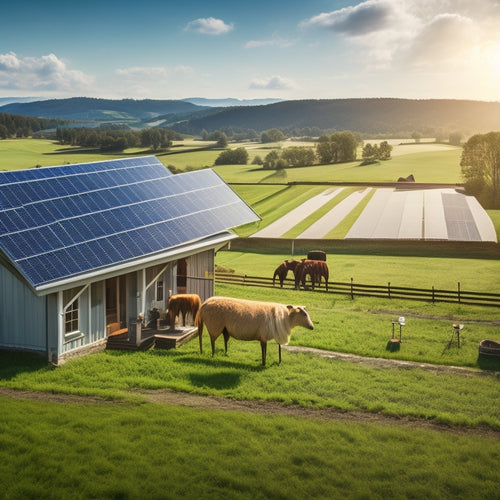
What Commercial Solar Installation Options Are Available Online?
Share
You can explore multiple commercial solar installation options online, including monocrystalline, polycrystalline, and thin-film panels, each suited for specific efficiency and space requirements. Choose between microinverters and string inverters, depending on shading and scalability needs. Mounting systems range from roof-mounted to ground-mounted and carport solutions. For energy storage, consider advanced battery options like lithium-ion and flow batteries, integrated with smart energy management systems. Installation packages vary from DIY kits to turnkey solutions, and maintenance services offer proactive system care. Financing choices include loans, leasing plans, and power purchase agreements. Dive deeper to uncover which combination best aligns with your commercial goals.
Key Takeaways
- Monocrystalline Panels: High efficiency, ideal for limited roof space, and long lifespan.
- Microinverters: Enhanced performance under shading and individual panel monitoring.
- Ground-Mounted Systems: Flexible placement, scalable, and suitable for extensive solar arrays.
- Energy Storage Solutions: Lithium-ion batteries for storing excess energy and maximizing efficiency.
- Turnkey Installation Packages: Comprehensive services including consultation, installation, and maintenance.
Types of Solar Panels
Understanding the various types of solar panels available can help you make an informed decision for your commercial installation. The three main types—monocrystalline, polycrystalline, and thin-film—each offer distinct advantages based on solar efficiency and panel lifespan.
Monocrystalline panels are known for their high efficiency, often exceeding 20%. Made from a single silicon crystal, they provide excellent performance and have a lifespan of around 25-30 years. These panels are ideal if you have limited roof space but need maximum energy output.
Polycrystalline panels, while slightly less efficient (15-17%), are more cost-effective. They're made from multiple silicon crystals and offer a good balance of performance and affordability. With a lifespan comparable to monocrystalline panels, they're a viable option for larger installations where space isn't as constrained.
Thin-film panels are the most versatile with applications but generally offer lower efficiency, around 10-12%. However, their lightweight and flexible nature make them suitable for unconventional or varied surfaces. Their lifespan ranges from 10-20 years, making them a shorter-term investment compared to their crystalline counterparts.
Inverter Options
Selecting the appropriate inverter is essential for maximizing the performance and efficiency of your commercial solar installation. The inverter converts the DC electricity generated by your solar panels into AC electricity, which can be used by your business.
You'll encounter two primary options: microinverters and string inverters. Microinverter advantages are numerous. They optimize the performance of each panel individually, making them ideal for installations where shading or varying panel orientations are an issue. They also simplify system monitoring, as you can track the performance of each panel.
String inverters, on the other hand, offer distinct pros. They're generally more cost-effective, making them suitable for larger installations with uniform sunlight exposure. They've fewer components, which often results in easier maintenance and longer lifespan.
Consider the following to make an informed decision:
- Microinverter Advantages: Enhanced performance under shading, individual panel monitoring, and simplified system expansion.
- String Inverter Pros: Cost-effectiveness for large, uniform installations, fewer components, and easier maintenance.
Market Trends: Increasing adoption of hybrid systems that combine both inverter types for optimized performance.
Mounting Systems
When considering mounting systems for commercial solar installations, you'll primarily look at roof-mounted solar panels, ground-mounted systems, and carport solar solutions.
Roof-mounted panels are a popular choice due to their space efficiency, while ground-mounted systems offer flexibility in larger open areas.
Carport solar solutions are gaining traction, providing dual benefits of energy generation and shaded parking.
Roof-Mounted Solar Panels
Roof-mounted solar panels, utilizing advanced mounting systems, have become a popular choice for maximizing energy efficiency and space utilization on residential and commercial buildings. When considering roof-mounted options, you'll need to address installation challenges and aesthetic integration to guarantee a seamless and effective solution.
Installation challenges can vary depending on your roof's material, slope, and structural integrity. It's important to work with experienced installers who can assess these factors and recommend the best mounting system. Common systems include fixed-tilt, adjustable-tilt, and ballasted mounts, each offering unique benefits and addressing specific challenges.
Aesthetic integration is another key factor. Modern mounting systems are designed to blend with your building's architecture, ensuring that solar panels don't detract from the overall appearance. Innovations like low-profile mounts and black-framed panels can greatly enhance visual appeal.
Market trends indicate a growing demand for roof-mounted solar solutions due to their efficiency and space-saving benefits. As technology advances, expect to see even more streamlined designs and easier installation processes.
-
Fixed-Tilt Mounts: Ideal for consistent angles and minimal maintenance.
-
Adjustable-Tilt Mounts: Allow for seasonal angle adjustments to maximize sun exposure.
-
Ballasted Mounts: Perfect for flat roofs, requiring no roof penetrations.
Ground-Mounted Systems
Ground-mounted solar systems offer an alternative to roof installations by providing flexible placement and easy maintenance, especially for properties with ample land space. If you manage large properties or agricultural applications, ground-mounted systems can be a highly efficient choice. They allow you to optimize the orientation and tilt of your solar panels for maximum energy capture.
One of the significant advantages of ground-mounted systems is their scalability. Large properties can benefit from extensive solar arrays without the limitations imposed by roof space. Additionally, these systems are easier to access for maintenance and upgrades, reducing long-term operational costs.
In agricultural applications, ground-mounted solar panels can be particularly beneficial. They can be installed in underutilized areas, such as field perimeters or non-arable sections, turning otherwise unused land into productive energy-generating zones. Specific designs like pole-mounted systems allow for adjustments that can accommodate seasonal changes in sunlight and crop cycles.
Market trends indicate a growing preference for ground-mounted systems in commercial and agricultural sectors due to their flexibility and efficiency. As the cost of solar technology continues to decrease, investing in ground-mounted systems becomes increasingly viable, offering a robust solution for sustainable energy needs.
Carport Solar Solutions
Carport solar solutions offer dual functionality by providing shaded parking spaces while simultaneously generating clean energy. These systems transform underutilized areas into productive assets, delivering substantial business benefits. Not only do they protect vehicles from harsh weather, but they also enhance sustainability and reduce energy costs.
Embracing carport solar solutions can yield considerable returns, particularly for businesses with large parking lots. These shade structures serve a dual purpose: maximizing space utility and demonstrating a commitment to environmental stewardship.
Here's why carport solar solutions are a smart investment:
- Increased Energy Savings: By harnessing solar power, you can significantly reduce your reliance on grid electricity, leading to lower energy bills.
- Enhanced Property Value: Solar carports can increase the overall value of your property by adding functional, attractive features that appeal to eco-conscious tenants and customers.
- Improved Customer Experience: Offering shaded parking can enhance convenience and comfort for customers and employees, reflecting positively on your business.
Market trends indicate a growing adoption of carport solar solutions due to their versatility and efficiency. As businesses increasingly prioritize sustainability, integrating these shade structures can set your company apart as a forward-thinking leader in clean energy.
Energy Storage Solutions
Energy storage solutions are essential for maximizing the efficiency and reliability of commercial solar installations. When you pair your solar panels with advanced energy storage systems, you effectively boost battery capacity, allowing your business to store excess energy generated during peak sunlight hours. This stored energy can be utilized during nighttime or cloudy days, ensuring continuous power supply and further advancing your grid independence.
In the current market, lithium-ion batteries dominate due to their high energy density and long lifecycle. However, it's important to explore options like flow batteries, which offer scalability and longer discharge times, especially useful for larger commercial setups. The integration of smart energy management systems can optimize how and when stored energy is used, reducing reliance on the grid and cutting electricity costs.
Emerging trends also point toward hybrid systems that combine solar with other renewable energy sources, enhancing overall system resilience. By investing in cutting-edge energy storage solutions, your commercial establishment can't only achieve greater energy autonomy but also contribute to a more sustainable future. Make sure to explore the latest technologies and market offerings to find the best fit for your specific needs.
Installation Packages
When optimizing your commercial solar installation, selecting the right installation package is key to maximizing your system's efficiency and return on investment. To start, you have a range of options that cater to different needs and budgets.
DIY kits are gaining popularity for their cost-effectiveness and flexibility. These kits come with all necessary components and detailed instructions, enabling you to manage the installation process with your in-house team.
For businesses with complex requirements or limited technical expertise, remote consultations offer a convenient solution. Expert installers can guide you through the process via video calls, ensuring that your setup meets industry standards without the need for an on-site visit. This approach saves time and reduces installation costs.
Additionally, turnkey installation packages provide a holistic solution, handling every aspect from initial assessment to final commissioning. These packages often include performance monitoring systems, giving you real-time insights into your solar array's output and efficiency.
-
DIY Kits: Ideal for cost savings and control over the installation process.
-
Remote Consultations: Perfect for remote guidance and ensuring compliance with industry standards.
-
Turnkey Packages: All-encompassing service covering assessment, installation, and monitoring.
Selecting the right package guarantees you get the most out of your commercial solar investment.
Maintenance Services
When you invest in commercial solar installation, it's important to prioritize maintenance services to guarantee peak performance.
Regular inspection schedules, thorough cleaning, and continuous system performance monitoring are essential to maximize efficiency and longevity.
Market trends show that thorough maintenance packages can greatly reduce downtime and operational costs.
Regular Inspection Schedule
To guarantee top performance and longevity of your commercial solar installation, a regular inspection schedule is essential. Consistent inspections help you address minor issues before they escalate, ensuring peak energy production and extending the system's lifespan.
Understanding inspection frequency is vital. Most experts recommend quarterly inspections, though this can vary based on your system's complexity and environmental factors. Regular inspections allow you to identify and rectify potential problems like loose connections, shading issues, or inverter faults.
A thorough maintenance checklist is indispensable. Key items to include are:
-
Visual Inspection: Examine solar panels for wear, tear, or dirt accumulation. Check mounting structures for any signs of corrosion or damage.
-
Electrical Checks: Ensure all wiring is intact and connections are secure. Test the inverter's performance and look for any error messages.
-
Performance Monitoring: Compare actual energy output with expected performance metrics to identify any discrepancies promptly.
The importance of a regular inspection schedule can't be overstated. Adopting a proactive maintenance approach aligns with current market trends, where businesses increasingly prioritize sustainability and cost-efficiency. By following a detailed maintenance checklist, you safeguard your investment and contribute to a greener future.
Cleaning and Upkeep
Maintaining your commercial solar panels clean and well-maintained is crucial for maximizing energy efficiency and prolonging the system's operational life. You have two primary options: professional cleaning services or DIY upkeep.
Professional cleaning services are highly recommended for large-scale installations. These experts utilize specialized equipment and eco-friendly solutions to remove dirt, debris, and bird droppings that can hinder panel performance. They also conduct thorough inspections to identify potential issues early on.
For smaller installations, DIY upkeep can be effective if performed regularly and correctly. This involves using soft brushes, non-abrasive cleaners, and deionized water to prevent scratches and mineral deposits. However, DIY methods require a significant time investment and may not be as thorough as professional services.
Here's a comparison of both options:
| Aspect | Professional Cleaning | DIY Upkeep |
|---|---|---|
| Cost | Higher initial cost | Lower initial cost |
| Efficiency | Highly efficient and thorough | Varies based on technique and tools |
| Frequency | Typically scheduled periodically | Requires more frequent attention |
Staying on top of cleaning and upkeep ensures your commercial solar investment remains efficient and productive. Choose the method that best aligns with your budget and maintenance capabilities.
System Performance Monitoring
Monitoring the performance of your commercial solar system is just as vital as its regular cleaning and upkeep to guarantee peak energy production and identify issues promptly. Leveraging advanced data analytics and remote diagnostics tools, you can stay ahead of potential problems and optimize system efficiency.
Real-time monitoring platforms provide detailed insights into various performance metrics, including energy output, system health, and component behavior. These platforms often feature user-friendly dashboards that allow you to visualize data trends and receive automated alerts for any anomalies.
Here are some advantages of robust system performance monitoring:
-
Increased Efficiency: By analyzing data in real-time, you can make informed decisions to maximize energy production.
-
Proactive Maintenance: Remote diagnostics enable you to identify and address issues before they escalate, reducing downtime and repair costs.
-
Performance Reporting: Generate detailed reports to understand system performance over time, helping you make data-driven adjustments and improvements.
In today's market, many commercial solar providers offer these advanced monitoring services as part of their maintenance packages. Staying informed about your system's performance not only ensures smoother operations but also enhances the return on your solar investment. Keeping your system at its best is now easier and more efficient than ever with these cutting-edge technologies.
Financing Plans
Exploring the myriad financing plans available for commercial solar installations can greatly impact your project's return on investment and long-term profitability. Among the most popular options are loan options and leasing plans. Loan options enable you to own the system outright, taking advantage of tax incentives and depreciation benefits. Typically, loans come with fixed interest rates and flexible terms, allowing you to spread the cost over several years while immediately benefiting from reduced energy expenses.
Leasing plans, on the other hand, require no upfront capital. Instead, you enter into a contract with a solar provider who installs and maintains the system. You then pay a fixed monthly fee. This arrangement can be particularly advantageous if your business prefers to keep capital expenditures low while still enjoying the benefits of solar energy.
Market trends indicate a growing preference for Power Purchase Agreements (PPAs), a type of lease where you only pay for the electricity generated, often at a lower rate than your utility provides.
Both financing options have their merits, and the best choice depends on your financial strategy, tax situation, and energy needs. Evaluating these factors will help you make an informed decision that aligns with your business goals.
Warranties and Support
Once you've settled on a financing plan, it's vital to thoroughly examine the warranties and support services that accompany your commercial solar installation. The warranty duration can vary greatly between providers, so it's important to understand what each company offers. Generally, you should look for warranties that cover at least 20-25 years for the solar panels and around 10 years for inverters. A longer warranty duration often indicates a more reliable product.
Support channels are equally essential. Immediate and effective support can minimize downtime and maximize system efficiency. Make sure the provider offers multiple support channels, such as phone, email, and live chat, to address any issues promptly. Some top-tier companies also offer dedicated account managers and on-site support for more complex issues.
Here are key points to consider:
-
Warranty Duration: Look for long-term warranties to ensure product reliability and peace of mind.
-
Support Channels: Multiple and accessible support options can greatly enhance your experience.
-
Reputation and Reviews: Check online reviews and industry ratings to gauge the effectiveness of a company's support services.
Frequently Asked Questions
What Is the Average Lifespan of a Commercial Solar Installation?
You can expect the average lifespan of a commercial solar installation to be around 25-30 years. Regular maintenance schedules and understanding the degradation rate, typically around 0.5-1% annually, are essential for maximizing efficiency and longevity.
How Much Space Is Needed for a Commercial Solar System?
Think of your roof as a canvas. You'll need around 100 square feet per kW of solar panels. Ideal roof orientation and effective energy storage can maximize efficiency, ensuring your commercial solar system meets energy demands seamlessly.
Are There Any Government Incentives for Commercial Solar Installations?
Yes, there are government incentives for commercial solar installations. You can benefit from tax credits and rebate programs, which greatly reduce upfront costs, making solar investment more attractive given current market trends towards sustainable energy.
Can Commercial Solar Systems Be Integrated With Existing Power Grids?
Think of your solar system as a new symphony instrument, seamlessly integrating with the existing orchestra. Yes, commercial solar systems can achieve grid compatibility and power synchronization, ensuring smooth operation with the current power infrastructure.
How Long Does It Typically Take to Install a Commercial Solar System?
The installation timeline for a commercial solar system typically spans 3 to 6 months. Project stages include site assessment, design, permitting, procurement, and installation. Market trends show increasing efficiency and streamlined processes, reducing overall project duration.
Conclusion
You've got choices when it comes to commercial solar installations. From high-efficiency panels to smart inverters, robust mounting systems to advanced storage solutions, your options are vast. Installation packages simplify the process, while maintenance services guarantee longevity.
Financing plans make solar accessible, and warranties provide peace of mind. Staying updated with market trends and leveraging expert insights, you're empowered to make informed decisions that boost efficiency, save costs, and support sustainability.
Immerse yourself in solar, and illuminate your business's future.
Related Posts
-

Solar Power Systems for Cost-Effective Sustainability
Investing in solar power systems is a smart move for cost-effective sustainability. You can save about $1,500 annuall...
-

Solar Power Savings for Environmentally Aware Consumers
Switching to solar power lets you drastically cut your carbon footprint while saving money in the long run. Each kilo...
-

Solar Power Systems for Rural Properties
Solar power systems offer a reliable and efficient energy solution for rural properties, allowing you to gain energy ...


